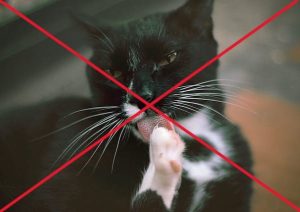Wounds are common injuries in cats and can take lots of different shapes and sizes.
There are many causes of wounds, such as a bite injury from another animal, a ruptured abscess, and cuts or lacerations from trauma.

What it’s for
Why do we clean cat wounds?
Wound cleaning is an extremely important step to help with wound healing. Some wounds will be closed with stitches to improve healing. Other wounds will be left open to heal due to their location, high levels of contamination, or not having enough skin to close.
The main goals of wound cleaning are to reduce contamination (including bacteria) and remove any foreign material or dead tissue.
Find out more about wounds.
How it’s done
How are cat wounds cleaned?
Most wounds, including cuts, lacerations, and bite wounds
- A sterile lubricant is put on the wound to allow the hair to be clipped without further contamination
- The hair is shaved to allow better vision of the area
- An initial flushing of the wound
- Removal of any foreign material or dead tissue
- Thorough flushing using sterile saline, chlorhexidine, or betadine solutions
- Next, the wound is stitched (sutured) closed, if needed
- Any protective coverings are then applied (more common for open wounds)
Abscesses
- Lanced (cut-open) and any pus drained
- Thoroughly cleaning
- A drain may be placed to allow extra fluid to be removed and prevent the wound from closing too soon
How to prepare your cat for wound cleaning
Keep the wound clean and dry, and prevent your cat from licking at it as much as possible.
Apply pressure if the wound is bleeding.
Do not apply any bandages at home; incorrect pressure can worsen wounds.
If your cat needs sedation or a general anaesthetic, they will likely need to be starved overnight beforehand.

Why your cat needs sedation or GA for wound cleaning
Most wounds, especially those that need stitches or staples, will need sedation or GA for cleaning. This is important for several reasons:
- To relax your cat if they get stressed or anxious at the vet clinic.
- To keep your cat restrained. Allows for a more thorough cleaning and for any surgery (such as stitches) to be done.
- Wound cleaning, stitches, or any other type of surgery are painful. Medications used for sedation or anaesthesia provide additional pain relief properties.
Costs
How much does it cost for wound cleaning?
The cost of wound cleaning can greatly vary depending on how severe the wound is, the type of practice (such as hospital or first opinion), and the area you are in.
Small, superficial wounds
- If no surgery or anaesthetic is required, then costs may be around £50-£200
Wounds that need sedation or GA and surgery
- Sedation and GA costs include monitoring equipment, extra staff, and specific medication. This often starts at around £100 or more, depending on how long the procedure lasts.
- Surgery prices will depend on what procedure is needed. This might involve straightforward stitches or be more complicated, involving drains, skin grafts, or flaps.
Other costs to consider:
- Bandaging (may need multiple appointments to change and refresh)
- Pain relief and antibiotic medications
- Imaging (x-rays, ultrasound) to check for damage elsewhere in the body
- Swabbing of the wound for culture and sensitivity
Risks
Is wound cleaning safe for cats?
Wound cleaning is generally a safe procedure for cats
Potential risks include bleeding, wound breakdown, and infection.
If your cat needs sedation or a general anaesthetic for wound cleaning, then there may be associated risks.
Recovery tips
How to help your cat after wound cleaning
Your vet will give you specific advice on how to care for your cat’s wound, depending on its location and severity.
- Keep the wound (and bandage) clean and dry at all times
- Check the wound at least once a day for any signs of concern, such as discharge or swelling
- Prevent licking, biting, and scratching at the wound at all times. You can do this by using a buster collar or pet medical suit.
- It is usually advised to reduce exercise until the wound is healed
- Gentle cleaning with saline may be advised if there is any discharge
- Give medications such as antibiotics or pain relief at the correct doses and times. Always complete the course.
- Topical treatments such as manuka honey or antibacterial wound creams may be advised. Do not use these unless advised by a vet or vet nurse.
When to worry
When you should be worried about wounds in cats
Seek help from a vet immediately if
- Your cat has a large or deep wound
- Your cat has a wound that won’t stop bleeding
- Your cat’s wound is infected
- Your cat is in pain with their wound
Call us and speak to one of our Joii Vets if
- Your cat has a small cut or graze
- Your cat has been bitten by another animal, and you don’t know what to do.








